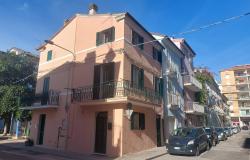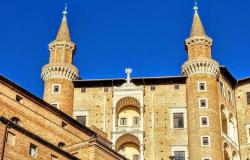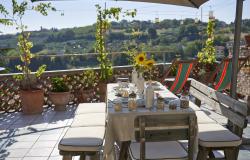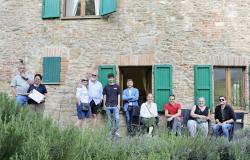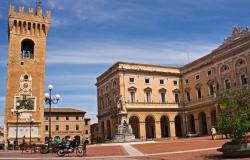On the way towards the south of Le Marche you might feel as if you are entering a beautiful landscape painting: golden hills gently rise towards the blue sky topped with bright green woodland and crowned by tiny stone villages.
Le Marche derives its name from the German word Mark, meaning boundary or frontier. The term ‘Marche’ was used to include all the many border lands (singularly named Marca) of the Roman Empire, under the dynasty of the Ottoni family during the 10th century. Peculiarly, it is the only plural name in Italian to indicate just one region.
The best way to reach the south of the region is to arrive at Ancona airport, rent a car and drive along the narrow coast road. This stretch of Le Marche is marked to the west by a harsh landscape, where the high summits of the Apennines form the Monti Sibillini National Park.
To the east, the Adriatic provides resorts for summer holidays, with colourful coastal cities like San Benedetto del Tronto or Grottammare. In the centre, a handful of medieval towns and country villages lie still, surrounded by sunny hills.
Fermo and Recanati
 Driving down from Ancona to Ascoli Piceno, the capital of the province, a couple of stops along the way are highly recommended.
Driving down from Ancona to Ascoli Piceno, the capital of the province, a couple of stops along the way are highly recommended.
The first one is the small village of Recanati in Macerata province. Spread over the top of a hill almost 300 metres above sea level, the town is a wonderful ‘balcony’ to the surrounding countryside and mountains.
Recanati is centred on a few elegant, winding streets. At the centre is the romantic Piazza Leopardi, named after one of the major Italian poets, Giacomo Leopardi who was born here in 1776. and took inspiration for most of his literary
masterpieces from his home town and the surrounding, seemingly never-ending landscapes. Indeed, his most famous poem, L’Infinito (the infinite) known by heart by generations of Italians, was written while sitting on his favourite hill, a few steps from his house.
Fermo is another enchanting example of a typical medieval town. Grouped around the Sabulo hill, it is recognisable from afar thanks to its high position and to its white cathedral which dominates the town. Beauty in this borgo is to be found everywhere; from the tiny narrow streets and arcades, to the dark houses and the ancient buildings, to the cobbled streets and squares. All the streets lead to the central Piazza del Popolo and to the Gothic Duomo della Madonna. Walking through these narrow alleys, your eyes constantly take in glimpses of the sea, a wonderful presence in the distance.
Ascoli Piceno
 Ascoli is a perfect example of a marchigiana city, only one and a half hour’s drive from Ancona. This charming town of only 53,000 inhabitants has many beautiful ancient treasures and offers to the visitor’s eye a mixture of architectural styles, signs of its rich history.
Ascoli is a perfect example of a marchigiana city, only one and a half hour’s drive from Ancona. This charming town of only 53,000 inhabitants has many beautiful ancient treasures and offers to the visitor’s eye a mixture of architectural styles, signs of its rich history.
Ascoli is a place where people live quietly and where local customs and traditions still have a deep meaning. Conveniently located at the confluence of two rivers, the Castellano and the Tronto, the city held a strategic role for the Roman Empire on the way to the Adriatic Sea. Signs of Roman and medieval splendour can be found everywhere in the streets, or rue, as the piceni call them, from the Latin ruga (channel). An extraordinary example is the Solestà Bridge, built under the emperor Augustus to improve communications with Rome.
Marble grey is the predominant colour of the city, due to the stone known as travertino from which the whole of Ascoli is built. This gives a severe and somehow solemn aspect to the narrow streets and the wide squares of this ancient town.
The city is centred around two main piazze, only a hundred metres from each other: Piazza Arringo and Piazza del Popolo.
The first one is more ancient and occupies the place where the old Roman Forum was once held. The rectangular shape is surrounded by buildings of different ages and styles among which the spectacular Cathedral of Sant’ Emidio stands out with its severe, imposing air. Inside, in the Chapel of the Sacrament, is Carlo Crivelli’s famous masterpiece, the so-called Polyptych of St Emygdius.





